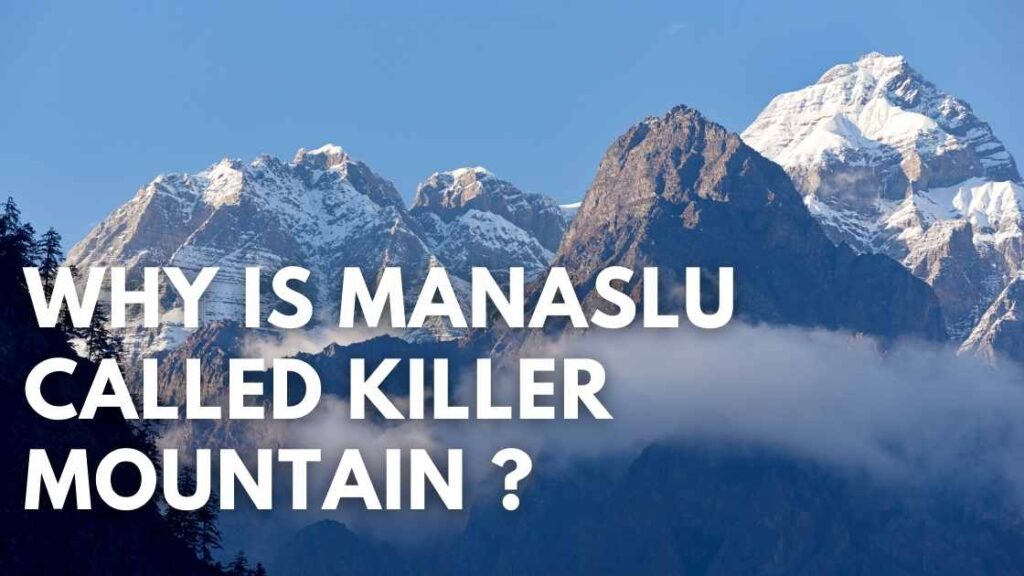Why is Manaslu called killer mountain? While its name translates as “Mountain of the Spirit.” It is known as “Killer Mountain” by residents. Manaslu is highly prone to avalanches. Despite having fewer climbers, it has the highest death rate registered. As per analysis, Manaslu has 9 deaths in every 100 victorious attempts.
Although many individuals choose Manaslu as their second preference mountain, some are attracted to its authentic beauty. Located in the Himalayas, the ‘Killer Mountain’ attracts adventurers from all over the world. Let’s discover the secrets behind this chilling nickname and understand why Manaslu is both thrilling and dangerous.
Causes for Death in Manaslu
- Serac Collapses: The presence of seracs, large blocks of ice, can pose a hazard to climbers if they collapse or break loose, causing injuries or fatalities.
- Altitude Sickness: The extreme altitude of Mount Manaslu can lead to altitude sickness, which can be life-threatening if not handled properly.
- Slides: The rough terrain and technical climbing sections increase the risk of falls, especially during challenging ascents and descents.
- Avalanches: Manaslu’s steep slopes and unpredictable weather conditions make it prone to avalanches, posing a considerable risk to climbers and mountaineers.
- Tiredness and Exhaustion: Climbing at a high altitude is physically demanding and can lead to exhaustion, impairing judgment and increasing the risk of accidents.
- Exposure: Climbers face harsh weather conditions, including extreme cold, high winds, and snowstorms, which can lead to hypothermia and frostbite.
- Rockfall: Unconsolidated rocks and residue on the mountain can fall unexpectedly, posing a danger to climbers below.
- Overcrowd: During peak climbing seasons, overcrowding on the mountain can increase the risk of casualties due to tie-ups on routes, longer wait times, and amplified competition for resources.
- Inexperienced Climbers: Lack of experience and proper training can contribute to accidents and fatalities on Mount Manaslu, especially in challenging conditions.
- Communication and Rescue Challenges: Remote location, limited communication options, and challenging terrain can interfere with rescue efforts in crises, delaying medical help.
The Big Deal About Altitude
Manaslu is a mountain that stands at an elevation of over 26,000 feet. At such high altitudes, the air becomes thin, which leads to difficulty breathing. Climbers should exercise additional carefulness and be aware of altitude sickness, which can unexpectedly affect them. Altitude sickness can lead to severe consequences, so climbers must be prepared to deal with it.
Tricky Terrain Ahead:
The slopes of Manaslu are not like a typical hill. They are steep and filled with unexpected possibilities. Avalanches, large blocks of ice falling (imagine ice boulders!), and hurried snow slides can occur. Climbing this mountain is solving a massive puzzle while preserving balance on tiptoes. Avalanches, icefalls, and the collapse of ice columns known as seracs contribute to the thrill and peril of the ascent.
Weather Heartaches:
The weather in Manaslu is unpredictable and can change rapidly. Climbers should prepare for blizzards, strong winds, and cold temperatures. It feels like continuously facing nature’s mood swings while being in a snowsuit.
Mother Nature doesn’t always play fair, especially in the Himalayas. Imagine sunny skies turning into raging blizzards in the blink of an eye. Sudden storms, fierce winds, and bone-chilling cold make every step on Manaslu a battle against the elements.
People Concerns:
Respecting the power of the mountain and adhering to safety rules are essential for a secure expedition. The presence of many climbers, inexperienced adventurers, or individuals disregarding safety guidelines can boost the danger. Just imagine trying to climb a mountain with inexperienced people. Human errors often lead to disastrous outcomes in otherwise difficult situations. Trails overcrowded with hikers, inexperienced climbers, and risky decision-making can transform an exhilarating adventure into a fatal mishap.
The Thrill of the Challenge:
However, despite the numerous risks involved, Manaslu continues to attract adventurers. It is almost like a dare, a challenge to determine if one possesses the necessary qualities to defeat its towering summits. Those who undertake the climb of Manaslu are not only in pursuit of excitement; they are also a profound connection with nature and a means of pushing their boundaries.
Conclusion: Why is Manaslu Called Killer Mountain
Despite its alarming nickname, Mount Manaslu continues to attract adventurers with its irresistible charm. It’s a place where bravery meets beauty, where every step is a victory over nature’s obstacles. With preparation, caution, and respect, conquering Manaslu becomes the adventure of a lifetime.
So, why is Manaslu called killer mountain? It’s not just because of its elevated heights or challenging terrain. It’s a reminder of nature’s power and the delicate balance between experience and safety. But for those courageous enough to answer its call, Mount Manaslu swears an extraordinary journey into the soul of the Himalayas.
Frequently Asked Questions (FAQs)
1. How long does it take to climb Manaslu?
The duration of a Manaslu depends on factors such as the chosen route, weather conditions, and individual climber experience. Typically, climbers consume around 4-6 weeks on the mountain, including time for acclimatization, establishing camps, and making summit attempts.
2. What are the risks of climbing Mt. Manaslu?
Climbing Mount Manaslu involves several risks, including altitude sickness, avalanches, crevasses, rockfall, and extreme weather. Altitude-related illnesses such as acute mountain sickness (AMS), high-altitude cerebral edema (HACE), and high-altitude pulmonary edema (HAPE) are common risks due to the high elevation of the mountain.
3. Are there any rescue facilities on the Manaslu expedition?
While there are no permanent rescue facilities on Mount Manaslu, there are helicopter rescue services available in case of emergencies. Climbers should have insurance coverage that includes helicopter evacuation. Carry communication devices such as satellite phones or emergency beacons for communication in case of emergencies.
4. What is the death rate of the killer mountain?
The death rate on killer mountain varies each year and depends on numerous factors such as weather conditions, climbing routes, and individual climber experience. While statistics on the exact death rate may vary (on average it states 9 deaths for every 100 successful attempts), climbing any 8,000-meter peak carries inherent risks, including altitude sickness, avalanches, falls, and adverse weather conditions.

